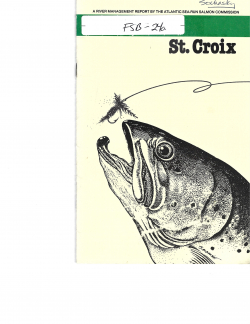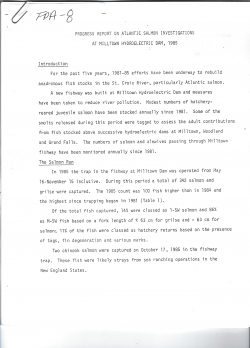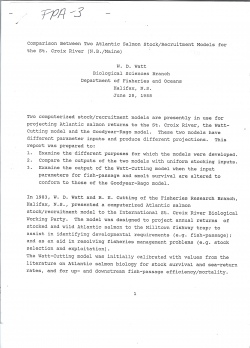Draft-A Review of Downstream Movements of Juvenile Atlantic Salmon (Salmo salar) in the Dam-Impact Saint John River Drainage

Type
Publication
Authors
JCarr ( Jonathan Carr )
Category
SCIWC Library
[ Browse Items ]
Publication Year
2001
Pages
76
Subject
Juvenile Atlantic Salmon in Dam-Impacted Saint John River
Tags
Abstract
"This report summarizes studies pertaining to the downstream movements of juvenile Atlantic salmon (Salmo salar) in the dam-impacted Saint John River drainage, New Brunswick. There is both an autumn and spring downstream migration of salmon within the drainage. Fish are subjected to increased mortality associated with hydroelectric dams due to delays and holdovers in headponds, and turbine and bypass problems.
An autumn downstream migration of parr (these fish are termed presmolt) occurs from various tributaries of the Saint John River drainage. These movements presumably position fish so that they can reach the ocean in the narrow time window available in the spring. Autumn movements have been recorded from the Nashwaak tributary (120 km from the ocean) to as far upstream as the Tobique tributary headwaters (400km from the ocean). Presmolt begin moving downstream when water temperatures drop below 13 [degrees Celsius], with peak movements occurring below 5 [degrees Celsius].
Most presmolt leave the Tobique River drainage in the autumn. some presmolt originating from the upper reaches of the Tobique River move to overwintering sites at least as far downstream as the Mactaquac headpond. However, others may over winter at sites along the way.
Water velocities are slow or nonexistent in headponds; consequently juvenile salmon migrants often become delayed and even trapped for an additional year in freshwater above the dams (these fish are termed holdovers). The most severe delays and holdovers occur in the Tobique and Mactaquac headponds. The rates of downstream movements in those headponds have been up to nine times slower than in the free-flow sections of the rivers. Based on study results, holdovers have been as high as 50% and 100% in the Tobique and Mactaquac headponds, respectively.
Turbine mortality for juvenile salmon is greatest at Tobique Narrows, where it is estimated at 18.4%. turbine mortality is estimated at 10% for both the Beechwood and Mactaquac dams. Predation both in headponds and in the tailraces downstream from dams may cause mortality, especially for hatchery fish stocked as presmolt or smolt.
Several measures have been implemented in other rivers to attempt to safely guide smolt through headponds and past dams. These measures have included screens and diversions, behavior stimuli, transportation, flow augmentation, and bypasses. No single mitigation technique has been successful at restoring salmon stocks in those systems. A combination of strategies may be effective at improving downstream survival of seaward salmon migrants. ultimately, the most effective technique is to breach dams to provide a free flowing river.
Mitigation measures are discussed for improving the survival of downstream salmon migrants past dams in the Saint John River drainage. The most promising measures may be transportation around the dams, flow augmentation, and surface bypasses.
An autumn downstream migration of parr (these fish are termed presmolt) occurs from various tributaries of the Saint John River drainage. These movements presumably position fish so that they can reach the ocean in the narrow time window available in the spring. Autumn movements have been recorded from the Nashwaak tributary (120 km from the ocean) to as far upstream as the Tobique tributary headwaters (400km from the ocean). Presmolt begin moving downstream when water temperatures drop below 13 [degrees Celsius], with peak movements occurring below 5 [degrees Celsius].
Most presmolt leave the Tobique River drainage in the autumn. some presmolt originating from the upper reaches of the Tobique River move to overwintering sites at least as far downstream as the Mactaquac headpond. However, others may over winter at sites along the way.
Water velocities are slow or nonexistent in headponds; consequently juvenile salmon migrants often become delayed and even trapped for an additional year in freshwater above the dams (these fish are termed holdovers). The most severe delays and holdovers occur in the Tobique and Mactaquac headponds. The rates of downstream movements in those headponds have been up to nine times slower than in the free-flow sections of the rivers. Based on study results, holdovers have been as high as 50% and 100% in the Tobique and Mactaquac headponds, respectively.
Turbine mortality for juvenile salmon is greatest at Tobique Narrows, where it is estimated at 18.4%. turbine mortality is estimated at 10% for both the Beechwood and Mactaquac dams. Predation both in headponds and in the tailraces downstream from dams may cause mortality, especially for hatchery fish stocked as presmolt or smolt.
Several measures have been implemented in other rivers to attempt to safely guide smolt through headponds and past dams. These measures have included screens and diversions, behavior stimuli, transportation, flow augmentation, and bypasses. No single mitigation technique has been successful at restoring salmon stocks in those systems. A combination of strategies may be effective at improving downstream survival of seaward salmon migrants. ultimately, the most effective technique is to breach dams to provide a free flowing river.
Mitigation measures are discussed for improving the survival of downstream salmon migrants past dams in the Saint John River drainage. The most promising measures may be transportation around the dams, flow augmentation, and surface bypasses.
Description
This document is a draft review of information pertaining to juvenile Atlantic Salmon movement in the St. John River.
Topics Include:
- Saint John River Drainage above Mactaquac
- Saint John River Stock Characteristics
- Sources of Mortality
- Global Measures for Reducing Mortalities
- Recommendations for Remediation in Saint John River
Topics Include:
- Saint John River Drainage above Mactaquac
- Saint John River Stock Characteristics
- Sources of Mortality
- Global Measures for Reducing Mortalities
- Recommendations for Remediation in Saint John River
Number of Copies
1
| Library | Accession No | Call No | Copy No | Edition | Location | Availability |
|---|---|---|---|---|---|---|
| SCIWC Administration | 13212 | FPA-29 | 1 | Yes |




